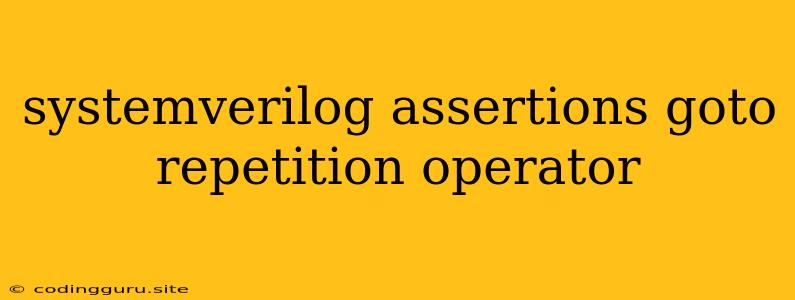Understanding SystemVerilog Assertions: A Comprehensive Guide
SystemVerilog assertions are powerful features that allow you to formally specify and verify the behavior of your hardware design. They provide a way to express complex relationships between signals and events, ensuring your design meets its intended functionality. In this comprehensive guide, we'll delve into the world of SystemVerilog assertions, exploring their purpose, syntax, and how they can be effectively utilized in your verification process.
What are SystemVerilog Assertions?
Imagine you're building a complex circuit, and you need to ensure it behaves exactly as you intended. You might write test cases, but how can you be absolutely sure your design works in all possible scenarios? That's where SystemVerilog assertions come in. They provide a formal way to describe the expected behavior of your design, allowing for automated verification and early detection of bugs.
Think of them as contracts: You define the rules and relationships your design must adhere to, and the assertion engine verifies if these rules hold true during simulation.
Why Use SystemVerilog Assertions?
Here's why you should embrace SystemVerilog assertions in your verification process:
- Early Bug Detection: Assertions catch errors early in the design cycle, preventing costly rework later on.
- Improved Code Readability: Assertions clarify the intended behavior of your design, making it easier for others to understand.
- Increased Verification Coverage: They provide a way to verify aspects that might be difficult to test with traditional testbenches.
- Enhanced Design Quality: Assertions enforce design constraints, leading to more robust and predictable designs.
Types of SystemVerilog Assertions
SystemVerilog offers two main types of assertions:
-
Immediate Assertions: Evaluated at every simulation time step.
- Syntax:
assert (condition) [severity]; - Example:
assert (reset == 1'b0) $error("Reset signal is high");
- Syntax:
-
Concurrent Assertions: Continuously monitored and evaluated throughout simulation.
- Syntax:
property my_property; ... endproperty; assert property(my_property); - Example:
property data_valid; @(posedge clk) data_valid == (valid && (data == expected_data)); endproperty; assert property(data_valid);
- Syntax:
Diving Deeper: Key Concepts and Techniques
1. Sequence:
Sequences are used to define a specific order of events or signal transitions. They are essential for expressing temporal relationships.
- Syntax:
sequence my_sequence; ... endsequence; - Example:
sequence data_transfer; @(posedge clk) valid == 1'b1; @(posedge clk) ready == 1'b1; endsequence;
2. Coverage:
SystemVerilog allows you to specify coverage points for your design. This helps identify areas where your verification isn't comprehensive.
- Syntax:
covergroup my_coverage; ... endcovergroup; - Example:
covergroup data_coverage; coverpoint data; endcovergroup;
3. Repetition Operator:
This operator is used to specify a desired number of repetitions within a sequence.
- Syntax:
sequence my_sequence; ... repeat(n) ... endsequence; - Example:
sequence multiple_writes; repeat(3) @(posedge clk) valid == 1'b1; endsequence;
4. goto Statement:
The goto statement allows you to jump to a specific location within a sequence or property. It can be used to create complex verification scenarios.
- Syntax:
goto label_name; - Example:
sequence my_sequence; @(posedge clk) valid == 1'b1; goto next_state; @(posedge clk) ready == 1'b1; label: next_state; ... endsequence;
5. Constraints:
Constraints define the valid ranges or values for signals within a property.
- Syntax:
constraint my_constraint; ... endconstraint; - Example:
constraint data_constraint; data dist { 0 := 50, 1 := 50 }; endconstraint;
Putting it all Together: Real-World Examples
Example 1: Data Transfer Protocol
property data_transfer_valid;
@(posedge clk) valid == 1'b1;
@(posedge clk) ready == 1'b1;
@(posedge clk) data == expected_data;
endproperty;
assert property(data_transfer_valid);
This assertion checks if the data_transfer_valid property holds true, ensuring that the data is transferred correctly with valid, ready, and data signals.
Example 2: Memory Access
property memory_write_valid;
@(posedge clk) write_enable == 1'b1;
@(posedge clk) address == expected_address;
@(posedge clk) data == expected_data;
endproperty;
assert property(memory_write_valid);
This assertion verifies that a write operation to memory is performed correctly with the expected address and data.
Conclusion
SystemVerilog assertions are essential for comprehensive verification of hardware designs. They provide a powerful mechanism for expressing complex behaviors, detecting errors early, and improving design quality. By understanding and implementing assertions effectively, you can significantly enhance your verification process and ensure that your designs meet their specifications. Remember, embracing assertions is a step towards building robust and reliable hardware systems.
